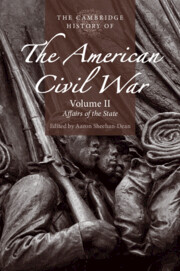Book contents
- The Cambridge History of the American Civil War
- The Cambridge History of the American Civil War
- The Cambridge History of the American Civil War
- Copyright page
- Contents
- Contributors to Volume II
- Note on the Text
- Part I Causes
- 1 The Antebellum War over Slavery
- 2 The Election of 1860
- 3 Secession and Disunion
- Part II Managing the War
- Part III The Global War
- Part IV Politics
- Index
- References
3 - Secession and Disunion
from Part I - Causes
Published online by Cambridge University Press: 11 October 2019
- The Cambridge History of the American Civil War
- The Cambridge History of the American Civil War
- The Cambridge History of the American Civil War
- Copyright page
- Contents
- Contributors to Volume II
- Note on the Text
- Part I Causes
- 1 The Antebellum War over Slavery
- 2 The Election of 1860
- 3 Secession and Disunion
- Part II Managing the War
- Part III The Global War
- Part IV Politics
- Index
- References
Summary
Secession was supposed to express solidarity rooted in a shared dream of Southern independence, but something was amiss. When Georgia legislators gathered in November 1860 to consider calling a state secession convention, debate in the quiet capital of Milledgeville turned cacophonous. At issue was whether Abraham Lincoln’s election was, as Thomas R. R. Cobb put it, “sufficient ground for the dissolution of the Union.” Cobb, an ardent secessionist later killed in action at Fredericksburg, answered emphatically in the affirmative. For years, he said, Northerners had attacked slavery by opposing its westward expansion, refusing to enforce the Fugitive Slave Law, admiring John Brown, and allowing abolitionists to preach their heresies. Things would only get worse under a Republican president. Lincoln could appoint antislavery zealots to federal offices in the South. He could withhold military aid during a slave revolt. He could plant abolitionists in the Supreme Court. Given these past crimes and future threats, who could counsel delay? Cobb conceded that if the issues were fleeting or superficial, like tariff rates, he would wait for Lincoln to make an overtly aggressive move. But safeguarding slavery was too important. “My friends,” exhorted Cobb, “there is danger in delay.” He urged “immediate, unconditional secession.”
- Type
- Chapter
- Information
- The Cambridge History of the American Civil War , pp. 43 - 62Publisher: Cambridge University PressPrint publication year: 2019



